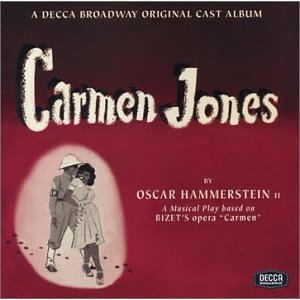
Carmen Jones is a 1943 Broadway musical with music by Georges Bizet and lyrics and book by Oscar Hammerstein II which was performed at The Broadway Theatre. Conceptually, it is Bizet's opera Carmen updated to a World War II-era, African-American setting. Bizet's opera was, in turn, based on the 1846 novella by Prosper Mérimée. The Broadway musical was produced by Billy Rose, using an all-black cast, and directed by Hassard Short. Robert Shaw prepared the choral portions of the show.

Harry Belafonte was an American singer, actor, and civil rights activist, who popularized calypso music with international audiences in the 1950s and 1960s. Belafonte's career breakthrough album Calypso (1956) was the first million-selling LP by a single artist.

Dorothy Jean Dandridge was an American actress and singer. She was the first African-American film star to be nominated for the Academy Award for Best Actress, which was for her performance in Carmen Jones (1954). Dandridge had also performed as a vocalist in venues such as the Cotton Club and the Apollo Theater. During her early career, she performed as a part of The Wonder Children, later The Dandridge Sisters, and appeared in a succession of films, usually in uncredited roles.

Laura Elizabeth Howe Richards was an American writer. She wrote more than 90 books including biographies, poetry, and several for children. One well-known children's poem is her literary nonsense verse Eletelephony.

Island in the Sun is a 1957 drama film produced by Darryl F. Zanuck and directed by Robert Rossen. It features an ensemble cast including James Mason, Harry Belafonte, Joan Fontaine, Joan Collins, Dorothy Dandridge, Michael Rennie, Stephen Boyd, Patricia Owens, John Justin, Diana Wynyard, John Williams, and Basil Sydney. The film is about race relations and interracial romance set in the fictitious island of Santa Marta. Barbados and Grenada were selected as the sites for the movie based on the 1955 novel by Alec Waugh. The film was controversial at the time of its release for its on-screen portrayal of interracial romance.

Sun Valley Serenade is a 1941 musical film directed by H. Bruce Humberstone and starring Sonja Henie, John Payne, Glenn Miller, Milton Berle, and Lynn Bari. It features the Glenn Miller Orchestra as well as dancing by the Nicholas Brothers. It also features Dorothy Dandridge, performing "Chattanooga Choo Choo", which was nominated for an Oscar for Best Song, was inducted into the Grammy Hall of Fame in 1996, and was awarded the first Gold Record for sales of 1.2 million.
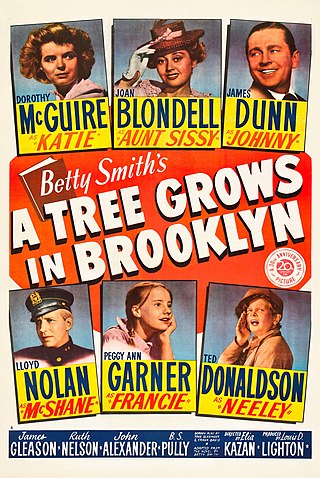
A Tree Grows in Brooklyn is a 1945 American drama film that marked the debut of Elia Kazan as a dramatic film director. Adapted by Tess Slesinger and Frank Davis from the 1943 novel by Betty Smith, the film focuses on an impoverished but aspirational, second-generation Irish-American family living in the Williamsburg neighborhood of Brooklyn, New York, in the early 20th century. Peggy Ann Garner received the Academy Juvenile Award for her performance as Francie Nolan, the adolescent girl at the center of the coming-of-age story. Other stars are Dorothy McGuire, Joan Blondell, Lloyd Nolan, Ted Donaldson, and James Dunn, who received the Academy Award for Best Supporting Actor for his portrayal of Francie's father.

Good Morning, Miss Dove is a 1955 American CinemaScope drama film that tells the sentimental story of a beloved schoolteacher who reflects back on her life and former students when she is hospitalized. It stars Jennifer Jones, Robert Stack, Kipp Hamilton, Robert Douglas, Peggy Knudsen, Marshall Thompson, Chuck Connors, and Mary Wickes.

Something Wild is a 1961 American neo noir psychological thriller film directed by Jack Garfein, and starring Carroll Baker, Ralph Meeker, and Mildred Dunnock. It follows a young New York City college student who, after being brutally raped, is taken in and held captive by a mechanic who witnessed her suicide attempt on the Manhattan Bridge. The film is based on the 1958 novel Mary Ann by Alex Karmel, who co-wrote the screenplay with Garfein.
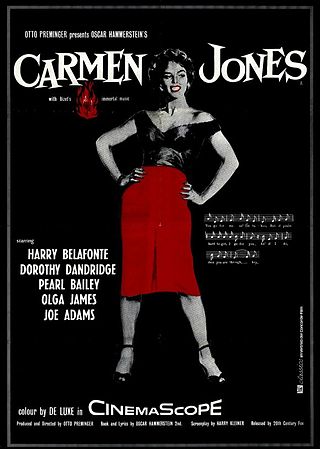
Carmen Jones is a 1954 American musical film featuring an African American cast starring Harry Belafonte, Dorothy Dandridge, and Pearl Bailey and produced and directed by Otto Preminger. The screenplay by Harry Kleiner is based on the lyrics and book by Oscar Hammerstein II, from the 1943 stage musical of the same name, set to the music of Georges Bizet's 1875 opera Carmen. The opera was an adaptation of the 1845 Prosper Mérimée novella Carmen by Henri Meilhac and Ludovic Halévy.

Vivian Alferetta Dandridge was an American singer, actress and dancer. Dandridge is best known for being the older sister of actress and singer Dorothy Dandridge and the daughter of actress Ruby Dandridge. Dandridge was a member of the Dandridge Sisters musical group, along with Etta Jones and Dorothy Dandridge from 1934 until the group disbanded in 1940. Dandridge went on to appear in minor roles on films and television from 1940 through the early 1960s. She never really achieved the same notable success as her younger sister, and Vivian Dandridge disappeared from the public eye by 1970. Dandridge died after suffering a stroke on October 26, 1991, at age 70.
The Devil to Pay! is a 1930 American pre-Code romantic drama film directed by George Fitzmaurice and starring Ronald Colman, Frederick Kerr, Myrna Loy and Loretta Young. It was written by Frederick Lonsdale and Benjamin Glazer.
The Dandridge Sisters were an American all-girl singing trio, started in 1934 in Los Angeles, California, and ended in 1940, comprising the sisters Vivian and Dorothy Dandridge together with their friend Etta Jones. They had a short period of fame traveling around the United States performing for night clubs, theatres, radio shows, and eventually left the U.S. to tour in Europe. Dorothy Dandridge decided to become a solo artist, the band split, and each woman then pursued projects individually.

Life Begins is a 1932 American pre-Code drama film starring Loretta Young, Eric Linden, Aline MacMahon, and Glenda Farrell. The film was adapted from the 1932 play of the same name by Mary M. Axelson. It was released by Warner Bros. on September 10, 1932. The film was praised for its honest portrayal of a maternity ward.
Donald Bogle is an American film historian and author of six books concerning black history in film and on television. He is an instructor at New York University's Tisch School of the Arts and at the University of Pennsylvania.

Divorce is a 1945 drama film about a much-divorced woman who sets her sights on her married childhood friend. It stars Kay Francis, Bruce Cabot, and Helen Mack.

Phil Moore was an American jazz pianist, arranger, and bandleader.
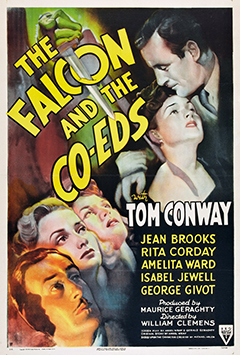
The Falcon and the Co-eds is a 1943 film under the direction of William Clemens, and produced by Maurice Geraghty, the same team that had worked on The Falcon in Danger (1943) and would stay together for the next film in the Falcon series. The Falcon and the Co-eds was the seventh of 16 in the Falcon series. The story and screenplay was by Ardel Wray, a frequent collaborator with Val Lewton in his RKO horror series, who added supernatural elements to the proceedings.

"Sisters at Heart" is the thirteenth episode of the seventh season, and 213th episode overall, of the American Broadcasting Company (ABC) fantasy television sitcom Bewitched. This Christmas episode aired on ABC on December 24, 1970, and again the following December.
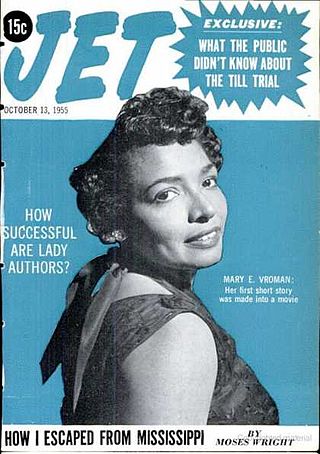
Mary Elizabeth Vroman was an American author of several books and short stories, including "See How They Run", a short story published in 1951.

















